Discover the Secrets of the Pantheon in Rome
The Pantheon, a magnificent ancient temple located in the heart of Rome, Italy, is one of the most significant architectural marvels in the world. With its rich history and remarkable design, it continues to captivate visitors from all corners of the globe, offering a glimpse into the grandeur of the Roman Empire.
Constructed by Emperor Hadrian between 118 and 125 AD, the Pantheon stands as a symbol of Roman engineering excellence and ingenuity. Originally dedicated to the pagan gods of Rome, it has since transformed into a Christian church, emphasizing its cultural and religious significance throughout history.
One of the most awe-inspiring features of the Pantheon is its massive dome, which remains the largest unreinforced concrete dome in the world. The impressive oculus, an opening at the top of the dome, allows natural light to flood the interior, creating a surreal and ethereal ambiance that leaves visitors in awe of the ancient craftsmanship.
Upon entering the Pantheon, visitors are greeted by the breathtaking interior, characterized by its imposing columns, intricate marble floors, and a sense of timeless grandeur. The architectural symmetry and balance of the space have inspired countless architects and artists throughout the centuries, serving as a testament to the enduring influence of Roman design.
Furthermore, the Pantheon houses the tombs of several notable figures, including the famous painter Raphael, adding an additional layer of historical and artistic significance to this iconic structure. The interplay of classical and Christian elements within the Pantheon's architecture reflects the complex and evolving nature of Rome's cultural identity.
Despite the passage of millennia, the Pantheon remains remarkably well-preserved, a testament to the enduring legacy of Roman engineering and construction techniques. Its enduring allure continues to draw scholars, historians, and tourists alike, all seeking to unravel the mysteries and secrets hidden within the walls of this extraordinary monument.
Visitors to the Pantheon can immerse themselves in the rich history of ancient Rome while experiencing the grandeur and splendor of one of the world's most renowned architectural wonders. The Pantheon stands as a testament to the ingenuity of the past, offering a window into the extraordinary achievements of the Roman Empire and its lasting cultural legacy.
Rome: Pantheon Guided Tour with Skip-the-Line Entry
Embark on a journey through history with a guided tour of the iconic Pantheon in Rome. Skip the long lines and dive into the rich past and remarkable architecture of this architectural masterpiece.
Meeting Point:
Meet your guide near the elephant statue at Piazza della Minerva, easily identifiable in a "Crown Tours" t-shirt.
Tour Highlights:
- Marvel at the world's largest unreinforced concrete dome's magnificent oculus
- Skip the lines with express security check for early entry
- Admire the fusion of Greek and Roman architectural elements
- Explore stunning mosaics, marble sculptures, and remarkable paintings
- Immerse yourself in ancient history with a knowledgeable local guide
What to Bring:
Passport or ID card for children. Please avoid bringing pets, shorts, weapons, sharp objects, short skirts, and sleeveless shirts.
Know Before You Go:
- The Pantheon is a church, so modest clothing is required
- The guided tour is conducted in English only
Customer Reviews:
Join the ranks of satisfied travelers who found value for money, with a 4.9/5 rating based on 231 reviews. Here's what some had to say:
"The tour was exactly what I wanted. The guide, Selenia, is really qualified and passionate about history and art."
- Lara, Italy
"Our guide, Jan, is amazing! He helped us appreciate the wonder of the Pantheon historically, architecturally, and culturally."
- Edelle, United States
Book Now:
Secure your spot and pay nothing today. Don't miss this opportunity to explore the Pantheon with a knowledgeable guide.
The History of the Pantheon in Rome
The Pantheon, located in the heart of Rome, is a remarkable ancient structure with a rich history that spans over two millennia. This iconic building has witnessed the rise and fall of empires, surviving the passage of time as a testament to Roman engineering and architectural prowess.
Originally commissioned by Marcus Agrippa during the reign of Augustus (27 BC - 14 AD), the Pantheon underwent several reconstructions before achieving its current form. The most notable reconstruction occurred under the emperor Hadrian in the 2nd century AD. The inscription on the façade proudly declares, "M·AGRIPPA·L·F·COS·TERTIUM·FECIT," acknowledging Agrippa's initial contribution to the construction.
The word "Pantheon" itself is derived from Greek, meaning "all the gods." This name reflects the building's original purpose as a temple dedicated to all Roman deities. The Pantheon's design is a testament to Roman innovation, featuring a massive domed roof with a central oculus, allowing natural light to filter into the rotunda. The dome, still considered an architectural marvel, remained the world's largest unreinforced concrete dome for centuries.
Over the centuries, the Pantheon's function evolved. It served as a temple, a Christian church, and eventually as a tomb for notable figures, including the artist Raphael and several Italian kings. Despite these transformations, the Pantheon's architectural integrity has been remarkably preserved.
During the Renaissance, the Pantheon captured the imaginations of artists and architects, influencing the design of numerous buildings across Europe. Its iconic dome and classical features became a symbol of classical beauty and inspired the likes of Michelangelo and Brunelleschi.
The Pantheon's enduring legacy is also marked by its role as a place of worship. In 609 AD, Pope Boniface IV consecrated the Pantheon as a Christian church, dedicated to St. Mary and the Martyrs. This act likely contributed to the preservation of the structure during times when other pagan temples faced destruction.
Today, the Pantheon stands as a living testament to the grandeur of ancient Rome. Visitors from around the world marvel at its architectural brilliance, reflecting on the layers of history embedded in its walls. The Pantheon's ability to seamlessly blend Roman engineering with artistic beauty ensures its place as one of the most iconic and well-preserved structures of the ancient world.
Rome: Pantheon Museum Guided Tour with Skip-the-line Ticket
Visit Rome's famous Pantheon Museum on a guided tour. Explore one of the most remarkable structures of the ancient world and marvel at the Pantheon's impressive collection of artifacts and artwork.
About this activity
As you enter the museum, you'll be greeted by an expert guide who will introduce you to the history and significance of the Pantheon. Be struck by its breathtaking dome, considered a masterpiece of Roman engineering, as you explore the Pantheon's interior. Next, move on to the Pantheon's impressive collection of artwork and artifacts, including the tomb of the famous painter Raphael, buried in the Pantheon in 1520.
Highlights
- Learn about the history and architecture of the Pantheon
- Marvel at the intricate design of the Pantheon's dome
- See ancient artwork and artifacts that tell the story of the Pantheon's past
- Gain a deeper understanding of Roman history and culture
Your guide will share stories about Raphael's life and work, and you'll learn about the impact he had on the art world during the Renaissance. Throughout the tour, your guide will provide you with insights into the rich history and cultural significance of the Pantheon. You'll leave the museum with a deeper understanding of this incredible structure and its place in Roman history.
Meeting point
Meeting point may vary depending on the option booked.
Important information
Not allowed: Shorts, Short skirts, Sleeveless shirts. The Pantheon is a church and requires modest clothing. Please provide age of each participant.
Save up to 20% from $30.46 $24.37 per person.
The Architecture of the Pantheon in Rome
The Pantheon is one of the most iconic and well-preserved architectural wonders of ancient Rome. Located in the heart of the Eternal City, this magnificent structure stands as a testament to the architectural and engineering prowess of the Roman Empire. With its unique design, incredible dome, and historical significance, the Pantheon has fascinated visitors for centuries.
The Pantheon's construction dates back to 27 BC, during the reign of Augustus, but the current building was commissioned by Emperor Hadrian around 126 AD. Its name "Pantheon" comes from the Greek words "pan," meaning all, and "theos," meaning god, which suggests its original purpose as a temple dedicated to all the Roman gods.
One of the most remarkable features of the Pantheon is its dome. The dome's design was groundbreaking in its time and remains a marvel of engineering. It is often cited as an inspiration for countless architectural works throughout history, including the dome of the Florence Cathedral and St. Peter's Basilica in Vatican City. The Pantheon's dome is a perfect hemisphere, with a diameter of 43.3 meters, and it was the largest dome in the world for more than a millennium.
The Pantheon's dome is made of concrete, a material Romans excelled at working with. The concrete was a combination of volcanic ash called pozzolana, which created a durable and lightweight substance. This innovation allowed the Romans to create enormous structures, such as the Pantheon's dome, which to this day remains a symbol of their architectural ingenuity.
The interior of the Pantheon is equally impressive. The central oculus, a circular opening at the top of the dome, serves as the building's only source of natural light. When it rains, the water flows through drains in the floor, and the interior is designed to channel airflow and create an ethereal, almost mystical atmosphere.
Another distinctive element is the Pantheon's portico, featuring massive granite columns quarried in Egypt. The bronze doors that once adorned the entrance were looted in the Middle Ages, but the impressive bronze ceiling inside, which is still in place today, reflects the grandeur of the original design.
The Pantheon has undergone various transformations over the centuries. In 608 AD, it was consecrated as a Christian church, which played a role in its preservation. During the Renaissance, the Pantheon was an inspiration for many architects and artists who sought to revive classical architectural elements.
Today, the Pantheon continues to be a popular tourist attraction, drawing visitors from around the world who come to admire its architecture and to experience the unique blend of history and art it represents. Its enduring legacy as a symbol of architectural innovation and cultural significance speaks to the timelessness of Roman design and engineering prowess.
In Conclusion
The Pantheon in Rome stands as an architectural masterpiece that has defied the ages. With its awe-inspiring dome, innovative use of concrete, and rich history, it remains a testament to the enduring legacy of Roman engineering and design. Visiting the Pantheon is not only a journey into the heart of ancient Rome but also an opportunity to appreciate the architectural brilliance that has inspired generations of architects and builders.


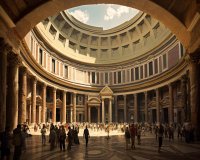
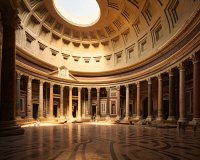
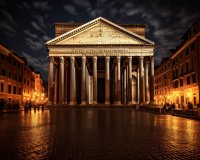
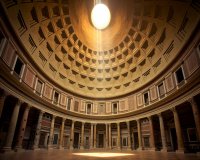

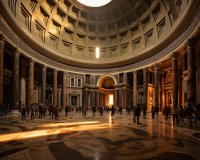

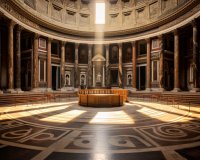

 The Gods of the Pantheon: Who Were They and Why Were They Worshipped?
The Gods of the Pantheon: Who Were They and Why Were They Worshipped?
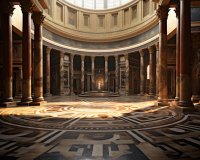 Inside the Pantheon: A Deep Dive into its Art and Architecture
Inside the Pantheon: A Deep Dive into its Art and Architecture
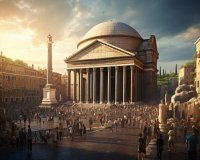 From Pagan Temple to Christian Church: The Spiritual Journey of the Pantheon
From Pagan Temple to Christian Church: The Spiritual Journey of the Pantheon
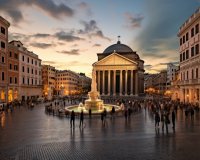 The Pantheon’s Neighbors: A Guide to the Surrounding Piazzas and Monuments
The Pantheon’s Neighbors: A Guide to the Surrounding Piazzas and Monuments